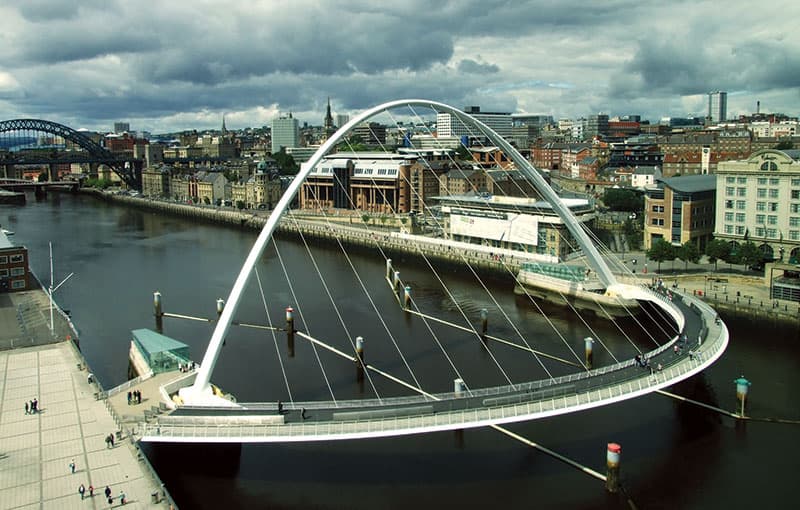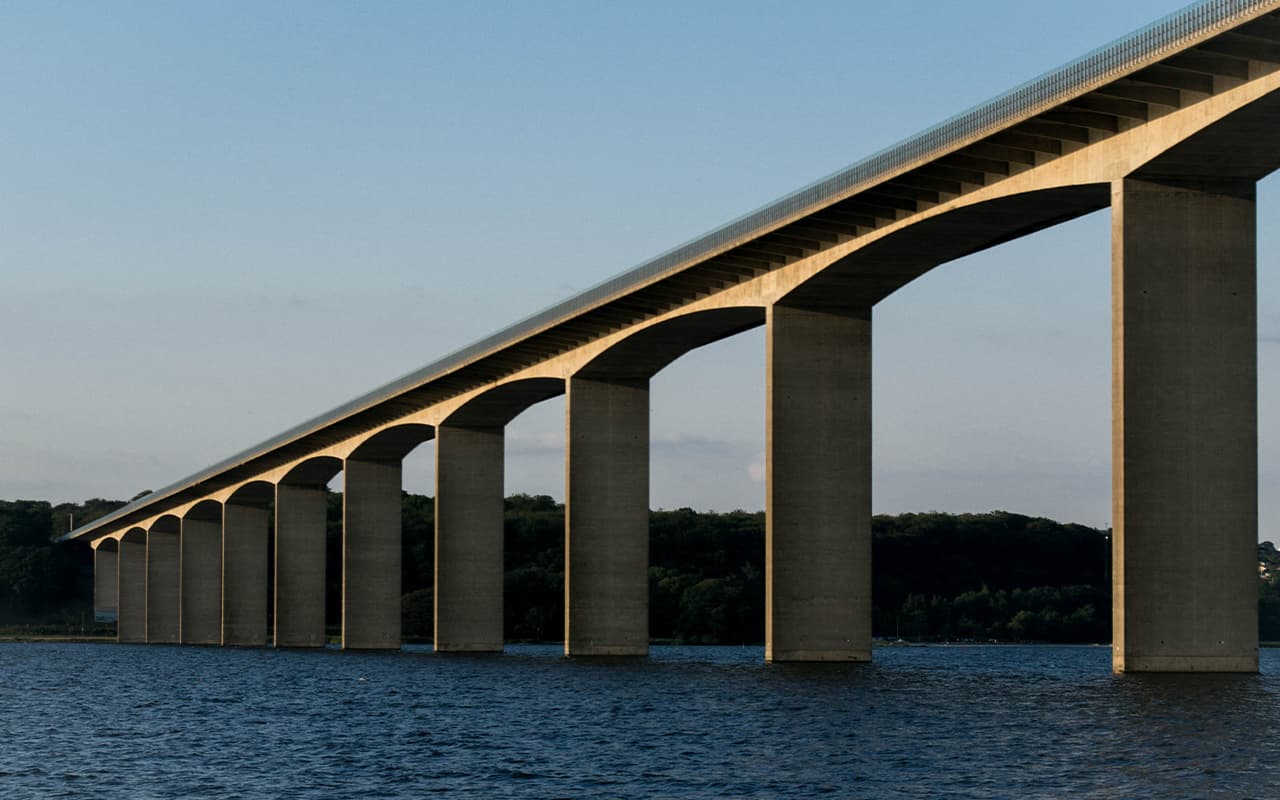Bridges stand as the quintessential embodiment of human ingenuity and engineering prowess. For centuries, they have connected communities, facilitated trade, and transcended geographical barriers, symbolizing the human aspiration to conquer the natural world. However, in the modern era, the demands placed on bridges have evolved exponentially, necessitating innovative materials and construction techniques to meet the challenges of the 21st century.
The construction of bridges is not merely about spanning distances; it is a testament to our ability to push the boundaries of architectural and structural engineering. In an era defined by rapid urbanization, increased traffic, and heightened environmental consciousness, bridge construction faces a unique set of challenges. Traditional construction methods, while reliable, often fall short in terms of efficiency, sustainability, and adaptability.
This text delves into the captivating world of innovative materials and cutting-edge techniques that are reshaping the landscape of modern bridge construction. From advanced composite materials to state-of-the-art design approaches, the engineering community is forging a new path towards safer, more sustainable, and aesthetically inspiring bridges.
The Role of Innovation in Improving Bridge Construction
Bridges have always been a testament to human innovation, reflecting our relentless pursuit of progress and the desire to overcome the challenges presented by the natural world. Over the centuries, bridge construction has witnessed significant advancements, from the simplest wooden spans to the awe-inspiring modern marvels that grace our skylines. Central to this journey has been the role of innovation, which continues to play a pivotal part in shaping the future of bridge construction.
- Enhancing Efficiency and Cost-Effectiveness:
Innovation in bridge construction has led to increased efficiency and cost-effectiveness. New materials and construction techniques often allow for quicker assembly and reduced labor costs. Prefabrication, for instance, enables large bridge components to be built off-site, minimizing construction time and traffic disruptions. This not only benefits project budgets but also minimizes the inconvenience to the public during construction. - Improving Safety and Durability:
Safety and durability are paramount in bridge construction. Innovative materials, such as high-strength steel alloys and corrosion-resistant coatings, enhance a bridge’s lifespan and reduce maintenance requirements. Cutting-edge design tools and simulations help engineers identify potential structural weaknesses, ensuring bridges are built to withstand the forces of nature and the test of time. - Sustainability and Environmental Impact:
In today’s environmentally conscious world, innovation in bridge construction extends to sustainable practices. Designing bridges with reduced carbon footprints, utilizing recycled materials, and incorporating green infrastructure elements like vegetated bridge decks are just a few examples. Innovations in environmentally friendly materials and construction methods help minimize the ecological impact of bridge projects. - Meeting Evolving Infrastructure Needs:
As infrastructure demands evolve, innovation allows bridges to adapt. Modern bridges must accommodate heavier traffic loads, high-speed trains, and the integration of smart technologies. Innovation is crucial in creating adaptable designs that can evolve with changing requirements and technologies. - Aesthetic and Architectural Advancements:
Innovation is not limited to the structural aspects of bridge construction. Creative design and architectural innovations play a significant role in enhancing a bridge’s aesthetic appeal. From iconic cable-stayed designs to visually stunning suspension bridges, innovation allows bridges to be both functional and works of art that define cityscapes. - Cross-Disciplinary Collaboration:
The role of innovation in bridge construction often requires cross-disciplinary collaboration. Engineers, architects, environmentalists, and materials scientists work together to push the boundaries of what is possible. This collaboration fosters a culture of innovation and continuous improvement.
Innovation is the driving force behind the evolution of bridge construction. It empowers engineers and architects to address the challenges of the modern world while preserving the essential functions of bridges as connectors of communities and enablers of progress. The chapters that follow will explore specific innovations in materials and techniques that are revolutionizing the way we conceive, design, and build bridges in the 21st century.
Innovative Materials in Bridge Construction
Modern bridge construction has seen a remarkable transformation through the integration of innovative materials. These advanced materials not only enhance the structural integrity of bridges but also contribute to their longevity, sustainability, and adaptability. In this section, we will explore some of the key innovative materials that are revolutionizing the field of bridge construction:
- High-Performance Concrete:
High-performance concrete (HPC) is engineered to exhibit exceptional strength, durability, and resistance to environmental factors. Its superior compressive and tensile strength allows for the construction of slender and more aesthetically pleasing bridge structures. HPC also possesses self-healing properties, enabling it to repair microcracks over time, thus increasing the lifespan of the bridge. - Fiber-Reinforced Composites:
Fiber-reinforced composites, including materials like carbon fiber and fiberglass, offer a remarkable strength-to-weight ratio. These materials are corrosion-resistant, reducing maintenance costs and extending the bridge’s service life. Composite materials are increasingly used in bridge components like reinforcement bars, bridge decks, and cables. - Smart Materials:
Smart materials, such as self-healing concrete and shape memory alloys, are paving the way for self-monitoring and adaptive bridges. Self-healing concrete contains capsules of healing agents that can repair cracks autonomously, enhancing durability. Shape memory alloys can change shape in response to temperature variations, allowing for adaptive structural responses in dynamic conditions. - Lightweight Materials:
Lightweight materials, like carbon fiber and aluminum, are being employed to reduce the weight of bridge components. This not only lowers construction costs but also minimizes the load on supporting structures and extends the life of the bridge. Lightweight materials are often used in the construction of pedestrian and cycling bridges. - High-Strength Steel Alloys:
High-strength steel alloys offer enhanced load-bearing capacity while maintaining a slender profile. These materials are crucial for constructing bridges that can withstand heavy traffic and seismic forces. Their use allows for longer spans and more efficient designs. - Innovative Wood Products:
Timber bridges are making a comeback with innovative engineered wood products. Cross-laminated timber (CLT) and laminated veneer lumber (LVL) are sustainable alternatives to traditional steel and concrete. They offer excellent strength properties and a natural aesthetic, making them suitable for a range of bridge types. - Nano-Engineered Materials:
Nanotechnology is contributing to the development of stronger and more durable bridge materials. Nanoparticles and nanofibers can be added to concrete and other construction materials to enhance their properties, such as resistance to cracking and chemical corrosion.
These innovative materials are at the forefront of modern bridge construction, offering engineers and architects the tools to create structures that are not only resilient but also environmentally sustainable. As we continue to push the boundaries of material science and engineering, bridges constructed with these materials are poised to shape the future of transportation infrastructure, connecting communities and fostering progress. The adoption of these materials in bridge construction represents a significant step towards safer, more efficient, and environmentally friendly bridge projects.
Advantages of Using Innovative Materials in Bridge Construction
The integration of innovative materials in bridge construction brings about a myriad of advantages that impact the longevity, efficiency, and sustainability of these essential infrastructure elements. Below, we explore the key benefits that arise from embracing these cutting-edge materials:
- Enhanced Structural Integrity:
Innovative materials often possess superior strength and durability properties compared to traditional counterparts. They enable the construction of bridges with greater load-bearing capacity, longer spans, and improved resistance to environmental factors, such as corrosion, seismic forces, and temperature fluctuations. - Reduced Maintenance Costs:
Many innovative materials are designed to be low-maintenance or self-repairing. By reducing the need for frequent inspections and repairs, these materials contribute to substantial cost savings over the bridge’s lifespan. Reduced maintenance also means less disruption to traffic and lower life-cycle costs. - Extended Service Life:
Bridges constructed with innovative materials have the potential for significantly longer service lives. This longevity ensures that the infrastructure investments made today will continue to serve communities for generations to come, ultimately providing a higher return on investment. - Improved Sustainability:
Sustainable construction practices are a top priority in today’s world. Innovative materials often incorporate eco-friendly elements, such as recycled content or reduced carbon footprints. Utilizing these materials aligns with environmental goals, reduces resource depletion, and minimizes the impact on ecosystems. - Enhanced Safety:
Superior materials contribute to safer bridges. They are less prone to structural failures, fatigue, and degradation, reducing the risk of accidents and improving overall safety for both bridge users and the surrounding environment. - Efficient Design and Construction:
Innovative materials can be engineered to be lightweight while maintaining strength, simplifying the construction process. This results in shorter construction times, reduced labor costs, and minimized traffic disruptions during bridge construction. - Aesthetic Freedom:
Many advanced materials offer greater design flexibility, enabling architects and engineers to create visually striking and iconic bridge structures. This aesthetic freedom can transform bridges into landmarks that enhance the character of a city or region. - Adaptability to Modern Needs:
Innovative materials are crucial for designing bridges that can accommodate modern transportation demands, including heavier traffic loads, high-speed rail, and emerging technologies. These materials enable the construction of adaptable and future-proof bridge designs. - Resilience to Climate Change:
Some innovative materials are designed to withstand the effects of climate change, including rising sea levels and increased temperature variations. They provide a vital component in constructing resilient infrastructure capable of withstanding evolving environmental challenges. - Global Competitiveness:
Embracing innovative materials in bridge construction enhances a nation’s global competitiveness. It showcases a commitment to infrastructure excellence, attracting investment, and fostering economic growth through improved connectivity.
The advantages of using innovative materials in bridge construction extend beyond mere engineering considerations. They touch upon economic, environmental, and societal aspects, enhancing the overall quality of infrastructure while addressing the challenges of the modern world. These materials exemplify the path forward in bridge construction, where innovation meets sustainability and resilience, ensuring that bridges continue to connect communities and foster progress for generations to come.
Modern Bridge Design Techniques
The art and science of bridge design have come a long way since the construction of the first simple wooden spans. Modern bridge design techniques encompass a wide range of innovative approaches, tools, and principles that empower engineers and architects to create structures that are not only functional but also aesthetically pleasing and environmentally sustainable. In this section, we will explore some of the key modern bridge design techniques that are shaping the landscape of contemporary infrastructure:
- Computer-Aided Design (CAD): Computer-Aided Design has revolutionized the way bridges are conceptualized and planned. CAD software allows engineers and architects to create highly detailed and accurate digital representations of bridge designs. These digital models facilitate collaboration, streamline the design process, and provide insights into structural performance and load distribution.
- Building Information Modeling (BIM): Building Information Modeling is an advanced design technique that extends beyond CAD. BIM integrates three-dimensional modeling with data-rich information, enabling multidisciplinary teams to work collaboratively throughout the project lifecycle. BIM offers real-time visualization, cost estimation, and clash detection, enhancing efficiency and reducing errors during construction.
- Parametric Design: Parametric design is an approach that uses algorithms to generate and manipulate design elements. It allows designers to explore a wide range of design possibilities quickly. In bridge design, parametric techniques can optimize structural form, materials, and aesthetics based on defined parameters, resulting in innovative and efficient solutions.
- Sustainable Design Principles: Modern bridge design embraces sustainability as a core principle. Sustainable design techniques consider environmental impact, energy efficiency, and resource conservation. Elements like green infrastructure, rainwater harvesting, and energy-efficient lighting are integrated into bridge designs to reduce the ecological footprint.
- Smart Infrastructure Integration: Bridges are increasingly designed to incorporate smart technologies, such as sensors, IoT (Internet of Things) devices, and data analytics. These technologies monitor structural health, traffic flow, and environmental conditions, enabling real-time maintenance and enhancing safety and efficiency.
- Adaptive Design for Climate Resilience: Climate change poses unique challenges for bridge design. Modern techniques involve designing for resilience, considering factors like rising sea levels, increased temperature variations, and extreme weather events. Adaptive designs may include elevated spans, flood-resistant materials, and reinforced foundations.
- Human-Centered Design: Modern bridge designs prioritize the needs and experiences of bridge users. Elements like pedestrian walkways, cyclist lanes, and scenic viewpoints are integrated into designs to create bridges that are not only functional but also enhance the quality of life for communities.
- Structural Analysis Tools: Advanced structural analysis tools, such as finite element analysis (FEA) and computational fluid dynamics (CFD), enable engineers to simulate and assess the performance of bridge structures under various conditions. These tools ensure that bridges meet safety and performance standards.
- Artistic and Aesthetic Integration: Modern bridge design goes beyond function to incorporate artistic and aesthetic elements. Architects and designers use innovative materials, lighting, and sculptural forms to create bridges that are iconic and visually appealing.
- Community Engagement: Modern bridge design often involves extensive community engagement to gather input and address local needs and concerns. Public participation ensures that the final bridge design reflects the values and aspirations of the community it serves.
Modern bridge design techniques represent a convergence of science, art, and sustainability. Engineers and architects leverage cutting-edge technology and design principles to create bridges that not only serve as functional infrastructure but also as symbols of progress and innovation. These techniques ensure that bridges are not just connectors of physical space but also catalysts for positive social and environmental change.
Conclusion
In the ever-evolving world of bridge construction, innovation stands as the cornerstone of progress, pushing the boundaries of engineering, architecture, and sustainability. As we conclude our exploration of “Innovative Materials and Techniques in Modern Bridge Construction,” we reflect on the profound impact of these advancements on our built environment and our interconnected world.
Throughout this text, we have journeyed through the realms of advanced materials and modern design techniques that are redefining the way we conceive, construct, and interact with bridges. From high-performance concrete and fiber-reinforced composites to parametric design and smart infrastructure integration, innovation has reinvigorated the field of bridge engineering.
The advantages of embracing innovation are manifold, encompassing enhanced structural integrity, reduced maintenance costs, extended service life, and improved sustainability. Modern bridges not only traverse physical landscapes but also bridge the gap between the past and the future, preserving the heritage of iconic structures while embracing the demands of contemporary society.
As we look ahead, it becomes apparent that the bridges of tomorrow will continue to be shaped by innovation. Emerging technologies, materials, and design philosophies will further enhance the resilience, adaptability, and efficiency of these vital infrastructure elements. The ongoing commitment to sustainability ensures that bridges will coexist harmoniously with the environment, minimizing their ecological impact.
Yet, behind the concrete and steel, beyond the algorithms and simulations, bridges remain symbols of human connection. They bring together communities, cultures, and aspirations. They enable commerce, facilitate travel, and bridge divides both physical and metaphorical. As we celebrate the cutting-edge materials and techniques that propel bridge construction into the future, we must remember that bridges are not just structures but lifelines that unite us all.
In the spirit of collaboration and innovation, we look forward to the next chapter in the saga of bridge construction, where engineering meets artistry, and where the impossible becomes attainable. As we continue to build the bridges that span our collective dreams and ambitions, may they serve as enduring monuments to human ingenuity and the unbreakable bonds that unite us across time and space.




